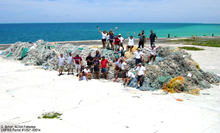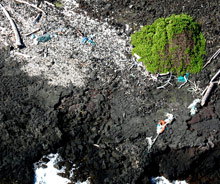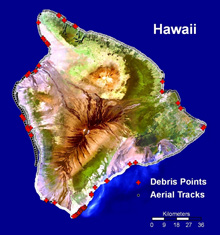Tackling Marine Debris in the Middle of the Pacific
Marine debris is an ongoing problem worldwide. With increased use of synthetic materials like plastic, marine ecosystems have suffered from the impacts of marine debris. The NOAA Marine Debris Program supports a national effort to prevent, identify, remove, and reduce marine debris and to protect and conserve our nation's natural resources and coastal waterways from the impacts of marine debris.

Each year tons of derelict fishing nets are removed from the reefs and shorelines of the NWHI. This photo illustrates the sheer amount of debris removed.
Mountains of derelict fishing gear and trash are strewn along an otherwise pristine Hawaiian beach. Hawaiian monk seals, green sea turtles, and humpback whales entangled in and injured from derelict fishing nets. These images highlight the need for increased marine debris efforts throughout the Hawaiian Islands. From entanglement and ingestion to vessel damage and alien species transport, marine debris in many forms is a problem that we cannot afford to ignore.

Marine debris is an entanglement threat to Hawaiian monk seals, the most endangered seal species in the United States. Click image for larger view.
The Hawaiian Archipelago, extending from the southernmost island of Hawaii, 1,500 miles northwest to Kure Atoll, is among the longest and most remote island chains in the world. Because of their location in the current gyres of the North Pacific Ocean, the Hawaiian Islands, including the recently designated Northwestern Hawaiian Islands (NWHI) Marine National Monument, are prone to accumulating floating debris. Each year, over 50 tons of marine debris from domestic and foreign sources wash ashore and snag on reefs across the island chain. In Hawaii, marine debris continues to present a hazard to marine habitat, safe navigation, and wildlife, including the endangered Hawaiian monk seal and various species of sea turtles, seabirds, and whales.
The NOAA Marine Debris Program: A Brief History
NOAA has worked to address the problem of marine debris for many years. From 1985 to 1996, NOAA administered the Marine Entanglement Research Program, a research and management program addressing the impacts of marine debris on wildlife. Since then, NOAA has continued to support and manage various marine debris projects, including international workshops, the NWHI debris removal, and a “ghostnet” satellite and remote sensing project.

Marine debris, such as derelict fishing gear, litter shorelines in the main Hawaiian Islands.
In 2005, Congress appropriated funding to re-establish a centralized marine debris capability within NOAA. This effort was aimed at organizing, strengthening, and increasing the visibility of marine debris efforts within the agency and its partners.
The mission of the NOAA Marine Debris Program (MDP) is to support a national and international effort focused on preventing, identifying, and reducing the occurrence of marine debris and to protect and conserve our nation’s natural resources, oceans, and coastal waterways from the impacts of marine debris. The program promotes research, monitoring, outreach, and reduction outcomes as recommended in the U.S. Commission on Ocean Policy and required in the U.S. Ocean Action Plan, the Marine Plastic Pollution Research and Control Act of 1987, and other mandates delegated to NOAA. The MDP also works closely with various partners across the U.S. to support research, prevention, and reduction of marine debris in efforts to fulfill the program’s mission.
Hawaiian Marine Debris
The issue of marine debris in Hawaii has garnered increasing attention over the last decade and even more so within the last few years. In 1996, the NOAA Pacific Islands Fisheries Science Center (PIFSC) began to address this pervasive problem by incorporating marine debris removal into its sea-going activities, focusing on the reefs and shorelines of the NWHI. Since 1996, 542 tons of derelict fishing gear have been removed from the NWHI and recycled into energy for Hawaii residents.

The southeastern Waiohinu-Ka Lae coast on the island of Hawaii is a known area of accumulation for marine debris within the main Hawaiian Islands. During 2005-2006, NOAA's Marine Debris Program funded a cleanup of this area. Click image for larger view.
In 1998, a multi-organizational marine debris group, consisting of federal, state, local, industrial, academic, and non-governmental organizations, realized the need to address the marine debris issue collectively. Since then, this group of partners has grown and the removal effort has increased in momentum, expanding to include projects in the main Hawaiian Islands and the recycling of marine debris to create electricity. One of the group’s newest partners is the NOAA Marine Debris Program.
The NOAA Marine Debris Program in Hawaii
In Hawaii, the NOAA MDP works cooperatively with various NOAA offices, as well as other marine debris partners to help protect Hawaii’s environment and address the problem of marine debris.

Aerial photo of marine debris along the lava rock shorelines near South Point on the island of Hawaii. Click image for larger view.
Today, the NOAA Marine Debris Program is working with the PIFSC on the first-ever comprehensive project to survey and remove marine debris in the main Hawaiian Islands.
Between February and May of 2006, aerial surveys of the main Hawaiian Islands of Oahu, Kauai, Hawaii, Maui, Lanai, and Molokai revealed the presence of marine debris along the shores and nearshore reefs of all the islands. In total, over 700 debris sites were found, comprising an estimated 129 tons (or 258,000 pounds) of marine debris.

Aerial photo taken of marine debris near South Point on the island of Hawaii. Click image for larger view.
PIFSC continues to work with state and county partners to prioritize cleanup areas, coordinate removal efforts, and identify sites for future monitoring. With the support of Hawaii’s multi-organizational marine debris group, all derelict fishing gear collected will be recycled to create electricity for Hawaii homes.
This main Hawaiian Islands marine debris project has “hit home” for many local residents, as impacted areas were sometimes, quite literally, in their backyards. Maps depicting the distribution of derelict fishing gear in the main islands are publicly available on the PIFSC Web site. Local media attention of this project has also helped to promote awareness and understanding of marine debris in Hawaii.
The Future of Marine Debris in Hawaii

Mapped debris locations on the island of Hawaii. GPS points were taken for each debris site located during aerial surveys, part of the main Hawaiian Islands marine debris location and removal project. Click image for larger view.
The PIFSC project is one of a series of marine debris projects in Hawaii focused on mitigation, prevention, reduction, and outreach and education. These projects are funded by the NOAA MDP and are part of a larger nationwide effort to address marine debris in coastal areas throughout the United States.
The road ahead is long, especially for this island state in the middle of the Pacific Ocean, battling one of the world's most pervasive forms of marine pollution: marine debris. However, through the ongoing efforts of NOAA programs, and with the support of partners such as Hawaii's multi-organizational marine debris group, the protection and conservation of our nation's natural resources and coastal waterways will continue.
Contributed by Carey Morishige and Seema Balwani, NOAA's National Ocean Service
Works Consulted
Gregory, M. R., & P. G. Ryan. (1997). Pelagic plastics and other seaborne persistent synthetic debris: a review of Southern Hemisphere perspectives. In J. M. Coe & D. B. Rogers (Eds.), Marine Debris-Sources, Impacts, Solutions (pp. 49-66). New York: Springer-Verlag.
